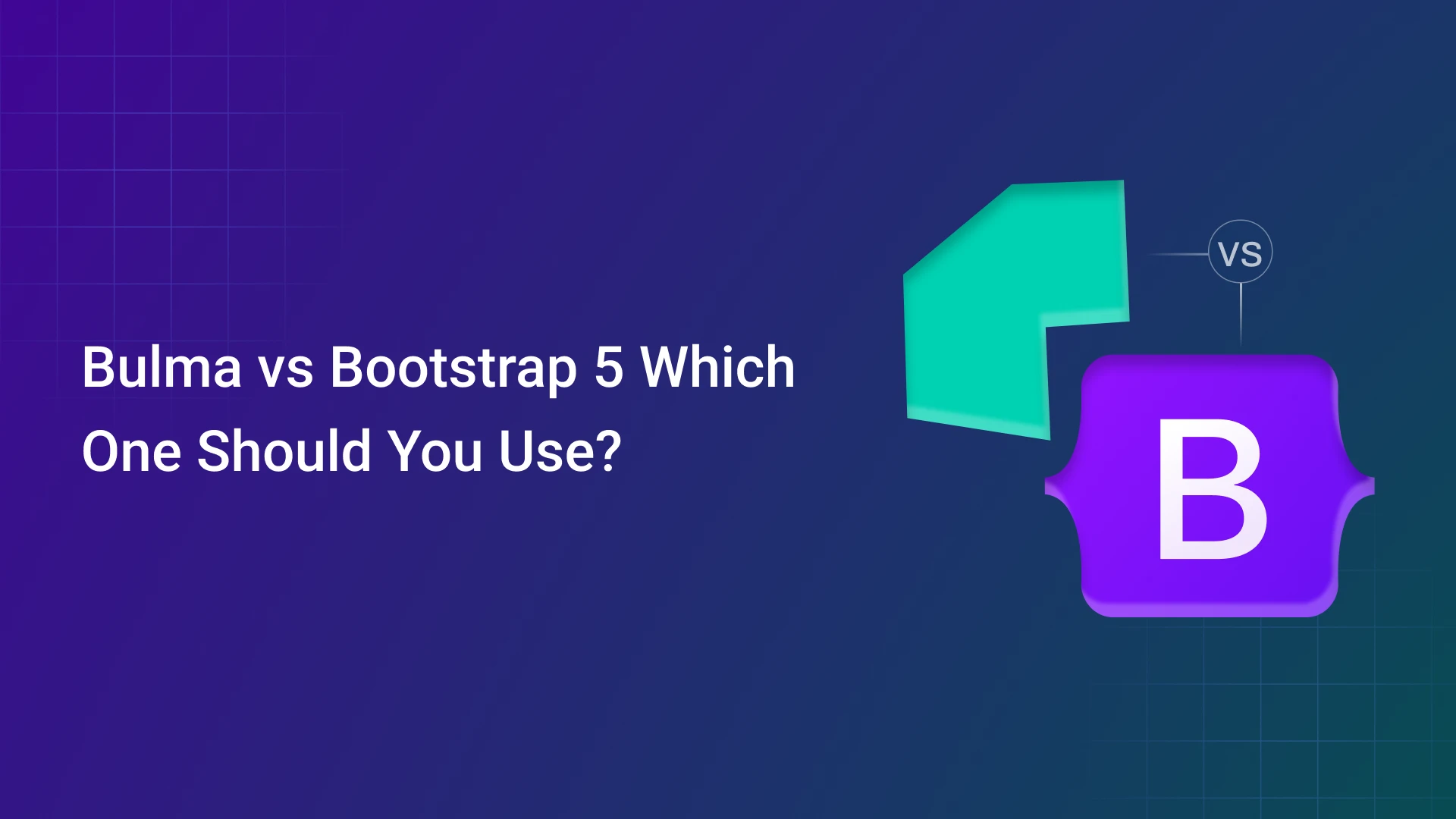
When developers talk about Bulma vs Bootstrap, we think the real question is this: Which CSS framework can help you build faster, smarter, and more modern websites in 2025?
In short, Bootstrap is still the heavyweight champion with the enormous ecosystem and JS integration, and Bulma is a very lightweight, clean, pure CSS framework.
But your choice is not a popularity contest. It depends on whether you need speed, customization, or a large library of components.
Quick Comparison: Bulma vs Bootstrap 5
Feature | Bulma CSS | Bootstrap 5 |
Core Type | Pure CSS framework | CSS + JavaScript framework |
Learning | Easy, beginner-friendly | Moderate, but more feature-rich |
Design Philosophy | Minimal, clean, and modern | Flexible, robust, enterprise-ready |
JavaScript Components | None | Built-in JS plugins |
Community Support | Growing, niche | Huge, long-established |
Best Use Case | Startups, MVPs, quick prototypes | Large-scale apps, enterprise sites |
Mobile-First | Responsive by default | Responsive grid system |
What is Bulma?
Bulma is a contemporary open source CSS framework that employs Flexbox. It is a pure CSS framework, meaning no extra JavaScript is included, or can be included for that matter. This allows developers to have control over the code.
Reasons people love Bulma:
- Lightweight and fast loading
- Intuitive syntax that will not intimidate beginners
- Fully responsive and mobile first
- Clean/minimal design system
- Ideal for rapid prototyping
If you’re looking for an alternative to Bootstrap that won’t bombard you with scripts or tons of unnecessary files, Bulma is a worthy consideration.
What is Bootstrap 5?
Bootstrap 5 is the most recent version of one of the world’s most popular frontend frameworks. It gives developers standard-designed UI components, a well-designed grid system, and plugins such as modals, carousels, and tooltips using CSS and JavaScript.
Why it stands out:
- Huge global community and ecosystem
- Tons of templates, UI kits, and documentation
- JavaScript components built in (don’t have to reinvent the wheel)
- Enterprise-level scalability
If you want to explore deeper comparisons, check out Bootstrap vs Tailwind CSS to see how Bootstrap stacks up against other frameworks.
Bulma vs Bootstrap 5: Detailed Feature Comparison
1. User Friendliness
- Bulma is beginner-friendly and easy to understand class-based syntax.
- Bootstrap 5 has more functionality, making it hard, but is great once learned.
2. Design Flexibility
- Bulma is Simple and great for modern, clean design.
- Bootstrap 5 is Borderline generic, tons of pre-styled components
3. Performance
- Bulma is Fast, lightweight because it is just CSS.
- Bootstrap 5 is not lightweight because of JavaScript.
4. Community
- Bulma has a Smaller community, but slowly growing.
- Bootstrap has a worldwide community, many tutorials, and third-party tools.
5. Use Cases
- Bulma: A great fit for MVPs, proofs of concept, and teams that want something simple.
- Bootstrap: A better fit for enterprise applications, dashboards, and more features.
Reading this Bulma CSS vs Bootstrap comparison makes it clear: both have their own area where they do well.
Bulma vs Bootstrap 5: Which is Better for Your Project?
1. For Beginners & Quick Learning
Bulma wins, its syntax is simple, straightforward, and easy for beginners.
2. For Large-Scale, Enterprise Projects
Bootstrap 5 wins, it has tons of JS components and a great supported community.
3. For Projects that Require Heavy Customization
Bulma gives you more options, it requires less default styling.
4. For MVPs, Prototypes, and Projects with Quick Deliverables
Bulma allows startups and small teams to build quickly without extra bloat.
5. When Working with Teams with Both High and Low Skill Levels
Bootstrap 5 is the safer option, because most developers are already aware of this framework.
Which Should You Choose in 2025?
Choose Bulma if you’re looking for speedy, simple, and entirely modern CSS (no accountability for using JS).
Choose Bootstrap 5 if you’re building enterprise-scale apps that will have a complete toolkit of components and support from a vibrant community.
Both frameworks are still around and still good, as of 2025. Which you decide is going to depend on whether you prefer slim simplicity or full-featured scalability.
FAQs
1. What are the differences between Bulma and Bootstrap?
Bulma is a CSS framework that doesn’t have any JavaScript, as Bootstrap 5 features a complete front-end framework that includes CSS and JS.
2. Is Bulma better than Tailwind and Bootstrap?
Bulma is simpler for a beginner to use than Tailwind, and is even less opinionated than Tailwind, but Bootstrap is still the most popular and has tons of components.
3. Why use Bulma?
Bulma is lightweight, beginner-friendly, and can create nice, clean, responsive designs.
4. How does Bulma differ from Material UI?
Bulma is a CSS framework in and of itself, whereas Material UI is a React-based library that also provides components based on Google’s Material Design.
5. Will Bulma be around in 2025?
Yes, people still actively use Bulma, particularly startups or teams who are building lightweight projects.
6. Can I use Bulma along with Bootstrap?
In theory, yes, but it’s not recommended because of the potential class collisions as well as the additional file size.



Leave a Reply